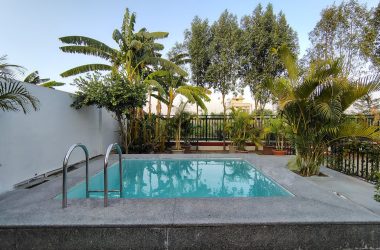Corrugated steel roofing has become a popular choice for both residential and commercial buildings due to its strength, affordability, and classic appearance.
Whether you’re planning a new build or replacing an old roof, understanding the features, installation process, and benefits of corrugated steel is essential. This article will walk you through everything you need to know to determine if it’s the right roofing solution for your project.
What is Corrugated Steel Roofing?
Corrugated steel roofing consists of sheets of steel that are formed into a series of alternating ridges and valleys. This unique shape provides strength and rigidity, making it a popular choice for various building types.
Often seen in commercial and agricultural structures, corrugated steel has made its way into residential applications, thanks to its durability and aesthetic appeal.
The manufacturing process typically involves galvanizing the steel, which protects it from rust and corrosion. This step not only extends the lifespan of the roofing material but also minimizes maintenance efforts over time.
Advantages of Corrugated Steel Roofing
Durability and Longevity
One of the standout features of corrugated steel roofing is its impressive lifespan. With proper installation and maintenance, these roofs can last anywhere from 40 to 70 years. They are resistant to harsh weather conditions including heavy rain, snow, and strong winds, making them ideal for various climates.
Their resilience also extends to fire resistance, a critical consideration for many building projects. Unlike traditional roofing materials, steel does not ignite, adding an extra layer of safety to your home or building.
Lightweight and Easy to Install
Corrugated steel is significantly lighter than other roofing materials like concrete tiles or asphalt shingles. This lightness simplifies the installation process, reducing both labor costs and time.
If you’re looking for a long-lasting yet cost-effective roof upgrade, corrugated roofing is one of the most practical solutions available today. The sheets can be quickly fastened to a wooden or metal frame, making it a preferred option for contractors.
Energy Efficiency
Incorporating reflective coatings on corrugated steel can enhance its energy efficiency. These coatings help reduce heat absorption by reflecting sunlight, which can lead to lower cooling costs during hot months. This attribute not only contributes to a greener environment but also results in savings on energy bills.
Aesthetic Appeal
Versatile Design Options
Gone are the days when metal roofs were merely utilitarian. Today, corrugated steel roofing is available in a variety of colors and finishes, allowing homeowners to choose styles that complement their architectural vision.
Whether you’re aiming for a modern, industrial look or a more traditional vibe, there’s a corrugated steel option to match.
Customization
Beyond color choices, corrugated steel can be customized in terms of profiles and thicknesses. This adaptability means that it can be used in both residential and commercial settings, allowing for creative freedom in design without compromising functionality.
Maintenance Considerations
Minimal Upkeep Required

One of the compelling reasons to choose corrugated steel roofing is the minimal maintenance required. Unlike asphalt shingles, which may need regular inspections and replacements, steel roofing is often self-cleaning. Rainwater can wash away debris and dirt, keeping it looking fresh.
Inspections and Repairs
While minimal, inspections should still be conducted periodically. Check for any loose screws or panels, especially after severe weather. If damage occurs, repairs can usually be done quickly and effectively, often without needing to replace entire sections.
Environmental Impact
Recyclability
Corrugated steel is highly recyclable, making it an environmentally friendly option. At the end of its life cycle, the material can be repurposed, thus reducing landfill waste. This characteristic aligns well with the growing trend toward sustainable building practices.
Energy Savings
Using reflective coatings not only aids in energy efficiency but also contributes to lower greenhouse gas emissions. The overall impact on energy consumption can be significant, especially in larger buildings that rely on cooling systems.
Cost Considerations
Initial Investment
While the initial cost of corrugated steel roofing can be higher than traditional materials, its longevity and durability often justify this expense. The investment pays off over time through reduced maintenance and replacement costs.
Long-Term Savings
The energy efficiency and longevity of corrugated steel can lead to substantial savings down the line. Property owners can expect lower utility bills and extended service life, turning what seems like a larger initial outlay into a smart financial decision.
Installation Process
Professional vs. DIY
Installing corrugated steel roofing can be a DIY project for handy individuals, but hiring professionals ensures proper installation and adherence to local codes. Professional installers are familiar with best practices, which can save time and potential headaches later.
Steps Involved
The installation process typically involves:
- Preparation: Ensuring the roof structure is sound and clean.
- Measuring and Cutting: Precise measurements are crucial for fitting the steel sheets correctly.
- Securing Panels: Using screws or clips to secure each panel in place, ensuring a tight fit to prevent leaks.
- Finishing Touches: Adding flashings and trims for a polished look.
Common Myths
Metal Roofs Attract Lightning
A common misconception is that metal roofs are more likely to attract lightning. In reality, metal does not attract lightning; rather, it serves as a safe pathway for electrical discharge. Buildings with metal roofs are as safe as any other roofing type.
Noisy During Rain
Another myth is that corrugated steel roofing is excessively noisy during rainstorms. The noise level can depend on the underlying structure and insulation. When installed correctly, the sound is often muffled significantly.
Choosing the Right Option
Assessing Your Needs
When selecting corrugated steel roofing, consider factors like climate, architectural style, and budget. Evaluate your specific needs and preferences, as these will guide your decision-making process.
Consulting Professionals
Consulting with roofing professionals can provide valuable insight. They can help you understand local building codes, recommend suitable materials, and guide you through the installation process.









